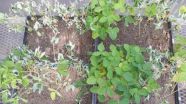(Press-News.org) URBANA, Ill. – With over 100 diseases that can attack soybean crops, why would charcoal rot rise to the top of the most wanted list? University of Illinois scientists cite the earth's changing climate as one reason that more research is needed on the fungus that causes charcoal rot.
Fungi may often be associated with cool, damp growing conditions but Macrophomina phaseolina, the fungus that causes charcoal rot, prefers hot and dry drought conditions.
"As the climate continues to change and we see more extremes in the weather, including hotter, drier summers, this fungus will have more favorable conditions to gain a foothold in soybean and other crops," said Osman Radwan, a U of I molecular biologist. "If we look at diseases of soybean, we find that soybean cyst nematode (SCN) is at the top, but in the past decade or so, charcoal rot has become one of the top 10 diseases that affect soybean yield."
In examining previous studies on charcoal rot, Radwan and his team noticed that worsening weather conditions associated with climate change, such as higher heat and drought, brought an increase in the incidence of charcoal rot in soybean. He suggests that a research strategy be created to develop a high-yielding soybean that is both resistant to charcoal rot and drought tolerant.
"Right now we are screening lines of soybean to charcoal rot and drought stress, in collaboration with Glen Hartman, a USDA-ARS and U of I plant pathologist," Radwan said.
"His team is screening for charcoal rot resistance, and I am screening for drought tolerance," Radwan said. "Our ultimate goal is to identify the line that shows resistance to both charcoal rot and drought stress and in this way improve soybean tolerance to both the pathogen and the extreme weather conditions."
The review of research on the subject has been written along with Hartman and Schuyler Korban from U of I. Radwan said that this background for what's already been done on the topic will help them to develop a strategy for the next step.
Radwan emphasized that it's not just soybean crops at risk. The fungus causes charcoal rot in about 500 other host plants, including corn, sorghum, sunflower, and other important crops. This fungus also grows in high concentrations of salt, which isn't much of a problem to growers in the United States, but it is for farmers in developing countries where salinity is considered an issue. Consequently, the plant must be able to tolerate drought, salt, and resist this fungus at the same time.
One intriguing direction Radwan described that shows promise is that there may be interactions between M. phaseolina and other soil pathogens such as soybean cyst nematode (SCN) and sudden death syndrome (SDS).
"We have some assumptions about whether SCN can increase or decrease the incidence of charcoal rot as resistance to both pathogens might be controlled by two different pathways," Radwan said. He explained that biotrophic pathogens such as SCN need plant tissue to survive, but the fungus that causes charcoal rot is necrotrophic, meaning that it kills the plant tissue, then lives on the dead plant cells.
"We need to understand at the molecular level how these two pathogens interact when they are present in soybean fields. Understanding the mechanisms of molecular interactions between SCN and M. phaseolina will help molecular biologists and breeders to design an effective method to control both diseases and to breed soybean for resistance to both pathogens," he said.
Although no plants have complete immunity from the fungus, some soybean lines have been shown to have partial resistance to it. Hartman's group has already begun screening many lines in soybean for resistance to charcoal rot.
In controlled greenhouse conditions, Radwan grows a variety of soybean cultivars in sandy soil and then stops watering the plants to simulate drought. The susceptible ones wilt and, even after adding water, don't recover. Those that are tolerant to drought survive.
"If we screen for drought stress, we hope to find some cultivars that are charcoal rot resistant and others that are drought tolerant so that we can cross them," Radwan said. "Of course, they also must have good agronomic traits, such as having a high yield potential, in order to be acceptable to farmers."
INFORMATION:
Genetic Mechanisms of Host-Pathogen Interactions for Charcoal Rot in Soybean was published in an issue of Plant Molecular Biology Reporter. Laura V. Rouhana, Glen L. Hartman, and Schuyler S. Korban contributed to the research.
Climate change provides good growing conditions for charcoal rot in soybeans
2014-07-09
ELSE PRESS RELEASES FROM THIS DATE:
Biologists link sexual selection and placenta formation
2014-07-09
RIVERSIDE, Calif. — Sexual selection refers to species' selection for traits that are attractive to the opposite sex. This special type of natural selection enhances opportunities to mate, the tail of male peacocks being an iconic example.
Biologists at the University of California, Riverside have now found that sexual selection and "placentation" — the formation of a placenta — are linked. Describing the life histories of more than 150 species of fish in the family Poeciliidae, the researchers found that species with placentas tend to have males that do not have bright ...
USF study: Amphibians can acquire resistance to deadly fungus
2014-07-09
Tampa, Fla. (July 9, 2014) – Emerging fungal pathogens pose a greater threat to biodiversity than any other parasitic group, causing population declines of amphibians, bats, corals, bees and snakes. New research from the University of South Florida published in the prestigious journal Nature reveals that amphibians can acquire behavioral or immunological resistance to a deadly chytrid fungus implicated in global amphibian population declines.
"Acquired resistance is important because it is the basis of vaccination campaigns based on 'herd immunity', where immunization ...
Fox Chase researchers recommend updating the staging criteria for breast cancer diagnoses
2014-07-09
New findings from Fox Chase Cancer Center paint a relatively optimistic picture of women's chances of surviving a subset of breast cancers that have spread to the chest wall or skin, but not beyond.
Tumors that grow into the skin, regardless of size and whether they have involved lymph nodes, are automatically classified as stage III – and called "locally advanced" tumors, suggesting that they are a relatively serious form of cancer, often with poor survival. Locally advanced breast cancers of this and other types account for five to ten percent of new breast cancer ...
MyChart use skyrocketing among cancer patients, UT Southwestern study finds
2014-07-09
DALLAS – July 9, 2014 – There has been a sharp increase in the number of cancer patients at UT Southwestern Medical Center using MyChart, the online, interactive service that allows patients to view laboratory and radiology results, communicate with their healthcare providers, schedule appointments, and renew prescriptions.
Over a six-year period, the number of patients actively using MyChart each year increased five-fold, while the number of total logins each year increased more than 10-fold, according to a study by Dr. David Gerber, Associate Professor of Internal Medicine, ...
New study finds that Adélie penguin population is on the rise
2014-07-09
A first-ever global census of Adélie penguins shows that the population is 3.79 million breeding pairs or 53 percent larger than previously estimated. Adélie penguins have long been considered a key indicator species to monitor and understand the effects of climate change and fishing in the Southern Ocean.
By using high-resolution satellite imagery, researchers from Stony Brook University and University of Minnesota have applied a new method that permits regular monitoring of Adélie penguins across their entire breeding range, and by extension the health of the Southern ...
Researchers declassify dinosaurs as being the great-great-grandparents of birds
2014-07-09
The re-examination of a sparrow-sized fossil from China challenges the commonly held belief that birds evolved from ground-dwelling theropod dinosaurs that gained the ability to fly. The birdlike fossil is actually not a dinosaur, as previously thought, but much rather the remains of a tiny tree-climbing animal that could glide, say American researchers Stephen Czerkas of the Dinosaur Museum in Blanding, Utah, and Alan Feduccia of the University of North Carolina. The study appears in Springer's Journal of Ornithology.
The fossil of the Scansoriopteryx (which means "climbing ...
Figuring out methane's role in the climate puzzle
2014-07-09
The U.S. may be on the verge of an economy driven by methane, the primary component of natural gas, which burns cleaner than coal and is undergoing a production boom. It has poised the country as a top fuel producer globally, but recent research is casting serious doubts over just how climate-friendly it is, according to an article in Chemical & Engineering News (C&EN), the weekly news magazine of the American Chemical Society.
In the article, Jeff Johnson, a senior correspondent at C&EN, explains that when burned as a fuel to produce electricity, methane emits about ...
Investigators from Montefiore and Einstein to present data at 2014 Alzheimer's Association International Conference
2014-07-09
NEW YORK (July 8, 2014) – Researchers from Montefiore Medical Center and the Albert Einstein College of Medicine of Yeshiva University will present new findings at the Alzheimer's Association International Conference (AAIC) being held July 12 – July 17 in Copenhagen, Denmark. Data from the four abstracts will focus on triggers that could prompt transition from cognitive normality to mild cognitive impairment and dementia. The research is part of the Einstein Aging Study, established in 1980 to examine healthy brain aging as well as the special challenges of Alzheimer's ...
Study predicts ranavirus as potential new culprit in amphibian extinctions
2014-07-09
KNOXVILLE—Amphibian declines and extinctions around the world have been linked to an emerging fungal disease called chytridiomycosis, but new research from the National Institute for Mathematical and Biological Synthesis (NIMBioS) shows that another pathogen, ranavirus, may also contribute.
In a series of mathematical models, researchers showed that ranavirus, which causes severe hemorrhage of internal organs in frogs, could cause extinction of isolated populations of wood frogs if they are exposed to the virus every few years, a scenario that has been documented in ...
Study of dermatology on YouTube shows new ways science reaches public
2014-07-09
p>YouTube is for more than watching World Cup highlights, Brian Williams refreshing old school rap classics, and videos of skateboarders landing in unfortunate positions on railings. A University of Colorado Cancer Center study published in the Dermatology Online Journal shows that YouTube also allows researchers, journals, and health advocates to connect directly with the public on topics of skin cancer and prevention.
"No matter what field you're in, social media is the future of how we communicate around the world," says Chante Karimkhani, MD candidate in the lab of ...







